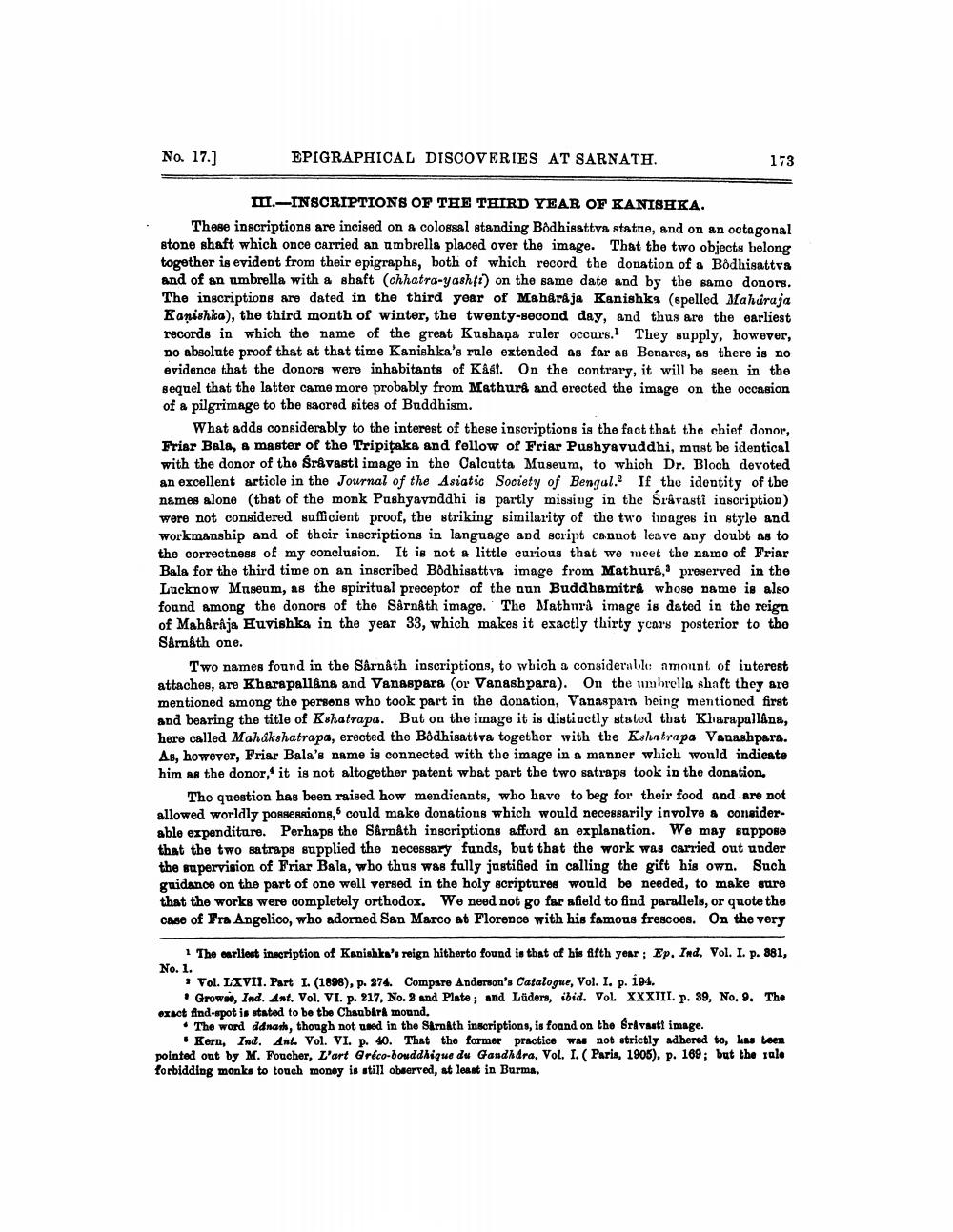________________
No. 17.]
EPIGRAPHICAL DISCOVERIES AT SARNATH.
173
M.-INSCRIPTIONS OF THE THIRD YEAR OF KANISHKA. These inscriptions are incised on a colossal standing Bodhisattva statue, and on an octagonal stone shaft which once carried an ambrella placed over the image. That the two objects belong together is evident from their epigraphs, both of which record the donation of a Bodhisattva and of an umbrella with a shaft (chhatra-yash(t) on the same date and by the samo donors. The inscriptions are dated in the third year of Maharaja Kanishka (spelled Mahúraja Kanishka), the third month of winter, the twenty-second day, and thus are the earliest records in which the name of the great Kushaņa ruler occurs. They supply, however, no absolute proof that at that time Kanishka's rule extended as far as Benares, as there is no evidence that the donors were inhabitants of Kåst. On the contrary, it will be seen in the sequel that the latter came more probably from Mathura and erected the image on the occasion of a pilgrimage to the sacred sites of Buddhism.
What adds considerably to the interest of these inscriptions is the fact that the chief donor, Frier Bala, a master of the Tripitaka and fellow of Friar Pushyavuddhi, must be identical with the donor of the śråvasti image in the Calcutta Museum, to which Dr. Bloch devoted an excellent article in the Journal of the Asiatic Society of Bengul. If the identity of the names alone (that of the monk Pushyavnddhi is partly missing in the Srávasti inscription) were not considered sufficient proof, the striking similarity of the two inpages in style and workmanship and of their inscriptions in language and script canuot leave any doubt as to the correctness of my conclusion. It is not a little curious that we meet the name of Friar Bala for the third time on an inscribed Bodhisattva image from Mathura, preserved in the Lucknow Museum, as the spiritual preceptor of the nun Buddhamitra whose name is also found among the donors of the Sårnåth image. The Mathura image is dated in the reign of Maharaja Huvishka in the year 33, which makes it exactly thirty ycars posterior to the Sårnåth one.
Two names found in the Sârnâth inscriptions, to wbich a considerable amount of interest attaches, are Kharapallâns and Vanaspara (or Vanashpara). On the umbrella shaft they are mentioned among the persons who took part in the donation, Vanasparn being mentioned first and bearing the title of Kshatrapa. But on the image it is distinctly stated that Kharapallana, here called Mahakshatrapa, erected the Bodhisattva together with the Kshatrapa Vanashpara. As, however, Friar Bala's name is connected with the image in a manner which wonld indicate him as the donor, it is not altogether patent wbat part the two satraps took in the donation.
The question has been raised how mendicants, who have to beg for their food and are not allowed worldly possessions, could make donations which would necessarily involve a considerable expenditure. Perhaps the Sårnáth inscriptions afford an explanation. We may suppose that the two satraps supplied the necessary funds, but that the work was carried out under the supervision of Friar Bala, who thus was fully justified in calling the gift his own. Such guidance on the part of one well versed in the holy scriptures would be needed, to make sure that the works were completely orthodox. We need not go far afield to find parallels, or quote the case of Fra Angelico, who adorned San Marco at Florence with his famous frescoes. On the very
1 The earliest inscription of Kanishka's reign hitherto found is that of his fifth year; Ep. Ind. Vol. I. p. 881, No. 1.
1 Vol. LXVII. Part I. (1898), p. 274. Compare Anderson's Catalogue, Vol. I. p. 194.
• Growse, Ind. Ant. Vol. VI. p. 217, No. 2 and Plate; and Lüders, ibid. VOL XXXIIL. P. 39, No. 9. The exact And-spot is stated to be the Chaubara mound.
The word ddnath, though not used in the Sarnath inscriptions, is found on the Srivasti image.
Kern, Ind. Ant. Vol. VI. p. 40. That the former practice was not strictly adhered to, kas toen pointed out by M. Foucher, L'art Gréco-bouddhique du Gandhdra, Vol. I. (Paris, 1905), p. 169; but the ralo forbidding monks to touch money is still observed, at least in Burma.




